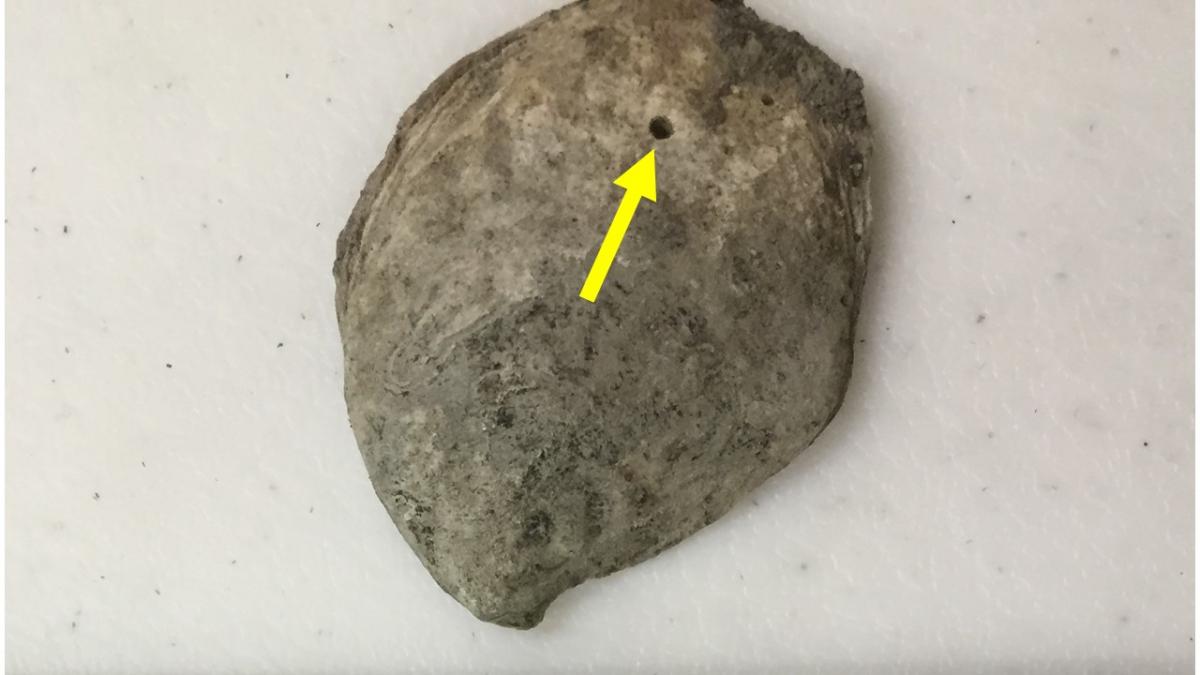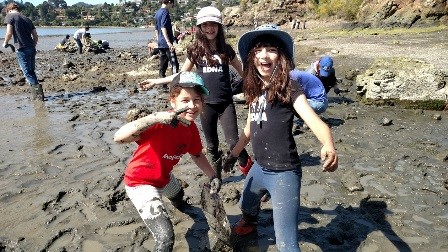* This project is not currently accepting new volunteers *
Oyster Drills in Richardson Bay
About the Project
Olympia oysters (Ostrea lurida) are native to San Francisco Bay but their populations have been declining for the last 150 years. Scientists from SERC and a number of other institutions have been working to restore the Olympia oyster populations in San Francisco Bay for over a decade. However, at some sites these efforts have been hampered by the intense predation by an invasive snail, the Atlantic oyster drill (Urosalpinx cinerea). These snails eat oysters, mussels, and barnacles. We want to know if there is a way to restore or increase oyster populations at site where drills are present.
History
 The Olympia oyster population began declining around the time of the Gold Rush (mid 1800’s). Following this increase of human presence, the oysters had to contend with overharvesting and pollution caused by gold mining. However, populations still remain even in the highly urbanized San Francisco Bay.
The Olympia oyster population began declining around the time of the Gold Rush (mid 1800’s). Following this increase of human presence, the oysters had to contend with overharvesting and pollution caused by gold mining. However, populations still remain even in the highly urbanized San Francisco Bay.
The Atlantic oyster drills are native to the East coast of the United States, and were likely introduced to the San Francisco Bay area in the late 1800’s by Atlantic oyster shipment. This larger, different species of oyster (Crassostrea virginica) was placed in the Bay in an attempt to start an aquaculture industry.
Efforts to restore or enhance Olympia oysters on the West Coast began in Puget Sound in 1999. Currently there are projects in British Columbia, Washington state, Oregon, and California. Challenges facing oyster restoration vary from place to place, but common issues include invasive species, sedimentation, estuarine acidification, and hypoxia. To learn more about Olympia oyster restoration and conservation, check out this website.
The "What" and the "Why"
What are we trying to learn?

We want to find out if removing oyster drills will increase oyster populations at sites where oyster drills are present. With the help of more than 150 volunteer scientists this year we removed over 14,000 oyster drills from two sites in Richardson Bay—within the San Francisco Bay, just north of the Golden Gate Bridge. We hope to repeat this effort and then follow up with surveys and field experiments to see if what we are doing is helping oysters survive.
Why do we care about oysters and oyster drills?

Oysters are filter feeders, which means they have a natural ability to improve water quality. Under certain conditions, Olympia oysters grow in clusters, which together form oyster beds (or reefs). The nooks and spaces created by clusters of oysters provide habitat for many small fish, crabs, and other marine creatures.
The Olympia oyster is the only oyster native to the West Coast of North America, and is a part of the native ecosystem. These oysters are part of healthy ecosystems in many West Coast estuaries and are still present even in the highly urbanized San Francisco Bay.
Native oysters can be incorporated into “living shorelines,” which use native species, such as eelgrass and various marsh plants to reduce shoreline erosion while providing habitat for many other native plant and animal species. There are many efforts to restore Olympia oysters as part of living shorelines in the San Francisco Bay, San Diego, Newport, and Humboldt Bays. In San Francisco Bay, native eelgrass, oysters, and marsh plants are used to create these shorelines, but invasive species like the oyster drill can hinder these efforts.
Methods

With help from members of the public, we are hand-removing oyster drills at two study sites in Richardson Bay to see if we can reduce the number of oyster drills to a point where Olympia oysters will be able to survive.
At each site we have set up a 50 meter “treatment” area of the shoreline in which we remove all of the oyster drills we can find! Researchers and volunteer scientists check over and under rocks and in mud, which can make it a messy activity. We plan the removals around the projected low tide—the lower the tide the easier it is to see the oyster drills!
At each site we also have a 50 meter “control” area where we are not removing drills. We use this area to compare drill populations to the “removal” area to see if the removal of oyster drills is helping oyster populations. In the future we hope to plant oysters, mussels, and barnacles on the shorelines to see if we have removed enough oyster drills to keep these native species alive.
Get Involved
* We are not currently accepting new volunteers *
Volunteers are critical to the success of this project! Volunteer involvement allows us to remove large numbers of oyster drills and ultimately helps us promote living shorelines, and healthy ecosystems!
Based on previous studies, we know that the best time to remove oyster drills is in the Spring. We'll be working with volunteers on some Saturdays and Sundays in March and April.
To sign up or to receive more information
Contact Rachael Mady, SERC Participatory Science Coordinator, at MadyR@si.edu or 443-482-2276.
Support for this project was provided by:

Partners for this project include:

Earlier Research
In previous years, we learned a lot about oyster drills and how far they can travel! In 2015, volunteer scientists helped researchers collect and tag 800 snails from four large rocks in Richardson Bay. Each snail was given an individual tag number, and rocks that snails were on were color-coded. All snails collected at a given rock were released from a common point at the base of that rock. Since each snail had its own number and colored tag, researchers and volunteer scientists were able to track the movement of the individual snails, and look at the population of oyster drills on the beach as a whole.
After 2 weeks, volunteer scientists worked with SERC researchers to search the rocks and surrounding mud flats for the tagged oyster drills, like an Easter egg hunt for marine biologists. We recorded the location of each tagged snail, and whether the snail was hidden (in a crevice or under a rock) or exposed. All rocks and mud flats were searched twice, by different team members. During the second round of searching, all tagged snails were collected and re-released from the base of their home rocks. Volunteers searched for snails again 6 weeks later.
What we discovered is that individual snails don’t travel very far! The farthest oyster drills traveled during this experiment was 15 feet. Because we know that oyster drills aren’t moving much, we hope that it is possible to remove the risk of oysters reducing oyster populations in a local area by removing the snails. This is the strategy that we are now pursuing! Removing snails regularly might aid the success of restoration efforts.


